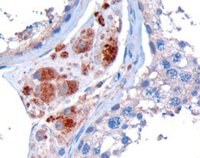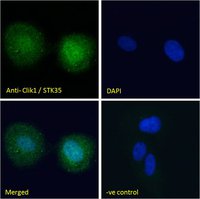Search
Type in product code or name:
Goat Anti-Clik1 / STK35 Antibody (EB06263)
| Code | Name | Applications | Availability | Size | Tested species | Price | Grade | |
|---|---|---|---|---|---|---|---|---|
| EB06263 | Goat Anti-Clik1 / STK35 Antibody | Pep-ELISA, WB, IHC, IF, FC | 100µg specific antibody in 200µl | Human, Mouse, Pig | $464.00 |  |
||
Ordering Information forOrder direct from EverestOrder offline99% of products are held in stock for immediate shipment, see individual product pages for availability. Please order through the US Dollar shopping cart (links on each product page) or we accept orders by email ([email protected])
In stock orders received by 11 am PST on Monday through Friday are shipped the same day. Orders are shipped by our parent company Vector Laboratories, 6737 Mowry Avenue, Newark CA 94560, USA. |
||||||||





Target Protein
Principal Names: STK35, Clik1, bA550O8.2, bA550O8.2 CLIK1, serine/threonine kinase 35, CLP-36 interacting kinase, CLIK1, STK35L1, OTTHUMP00000030006, serine threonine kinase 35 long formOfficial Symbol: STK35
Accession Number(s): NP_543026.2
Human GeneID(s): 140901
Non-Human GeneID(s): 67333 (mouse)
Immunogen
Peptide with sequence ELETRMDQVTCAA, from the C Terminus of the protein sequence according to NP_543026.2.
Please note the peptide is available for sale.
Purification and Storage
Purified from goat serum by ammonium sulphate precipitation followed by antigen affinity chromatography using the immunizing peptide.
Supplied at 0.5 mg/ml in Tris saline, 0.02% sodium azide, pH7.3 with 0.5% bovine serum albumin.
Aliquot and store at -20°C. Minimize freezing and thawing.
Applications Tested
Peptide ELISA: antibody detection limit dilution 1:16000.Western blot: Approx 55kDa band observed in Human Breast cancer and in Mouse and Pig Testis lysates, and approx. 58kDa in nuclear lysates of cell line HEK293 (calculated MW of 58.1kDa according to Human NP_543026.2, 59.5kDa according to Mouse NP_899085.3 and 59.2kDa according to XP_005672850.1 Pig XP_005672850.1). Recommended concentration: 1-3µg/ml. Primary incubation 1 hour at room temperature. This product has been successfully used in WB on Human: Goyal P et al, PLoS One. 2009 Sep 16;4(9):e6981. PMID: 19756140.
IHC: In paraffin embedded Human Testis shows granular cytoplasmic staining of Leydig cells. Recommended concentration: 10µg/ml.
Immunofluorescence: Strong expression of the protein seen in the nuclei of U2OS cells. Recommended concentration: 10µg/ml.
Flow Cytometry: Flow cytometric analysis of HEK293 cells. Recommended concentration: 10ug/ml.
Species Reactivity
Tested: Human, Mouse, PigExpected from sequence similarity: Human, Mouse, Rat, Dog, Pig, Cow
Specific Reference
This antibody has been successfully used in WB on Human:
Goyal P, Behring A, Kumar A, Siess W.
Identifying and characterizing a novel protein kinase STK35L1 and deciphering its orthologs and close-homologs in vertebrates.
PLoS One. 2009 Sep 16;4(9):e6981.
PMID: 19756140
Product Reviews
Please login to review this product.- Western blot Guidelines
- Everest Western blot labeling
- Western blot Trouble shooting guide
- IHC staining on paraffin sections
- Immunofluorescence Protocol
- Flow Cytometry Protocol
- MSDS - All Goat antibodies
- Tissue Lysate Preparation
- Cell Lysate Preparation
- Blocking with the immunizing peptide
- LsBio IHC Protocol
